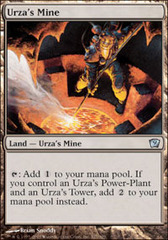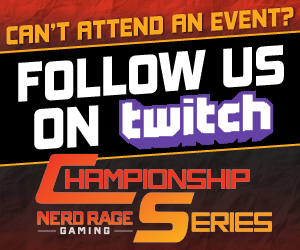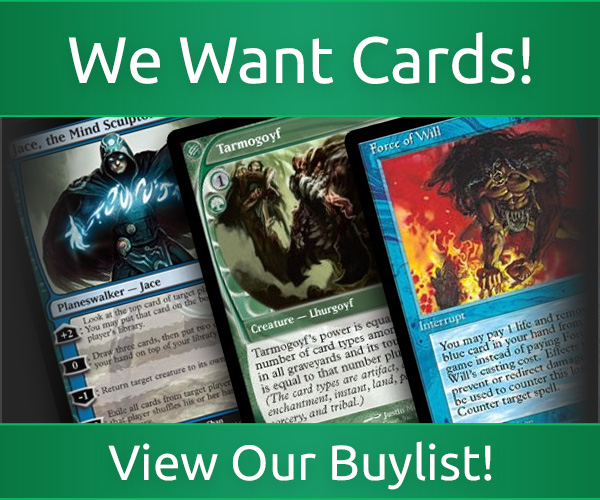The State of Modern: G/x Tron, by Brandon Lunt
Tron decks have been a pillar of Modern since the banning of Cloudpost nearly six years ago. Named after Voltron, which is a super robot made by smaller robots combining, Tron decks utilize Urza’s Tower, Urza’s Power Plant, and Urza’s Mine to overwhelm the opponent with a mana advantage.
I’ve been tapping lands for three mana as long as I’ve been playing Modern, and Tron has led me to three Nerd Rage Gaming CTQ Top 8s this year. However, recently Eldrazi Tron has taken the limelight away from its colorful relatives. I’d like to talk about traditional Tron variants and why you should start sleeving up some Expedition Maps and Wurmcoil Engines.
Before the Eldrazi forced their way into the format, the two most prevalent schools of Tron were Gx and Mono U, each with their own playstyle. Both are control decks that function very differently.
Gx Tron uses green spells, such as Sylvan Scrying, to quickly assemble the Tron lands while its splash of red, white, or black disrupts the opponent. Strong and consistent plays such as a turn three Karn Liberated or turn four Ulamog, the Ceaseless Hunger are devastating for many decks. The recently printed Fatal Push has put G/B Tron on the map with removal that rivals Path to Exile.
Conversely, Mono-U Tron is in no hurry to piece its lands together. This draw-go style deck employs an impressive suite of counters and bounce spells to stall the opponent, generating an advantage in both mana and cards. Thirst for Knowledge and Academy Ruins are excellent payoffs for running so many artifacts and you’ll often be locking the opponent out of the game with an endless amount of Mindslavers. I’ll go into more detail about Mono-U Tron later this week, but here I will be focusing on green variants of Tron.
The Deck
Let’s take a look at a recent list I’ve taken to an NRG CTQ:
G/B Tron, by Brandon Lunt, 2nd place, Modern CTQ, 5/13/17
No self-respecting Tron player would leave home without a full playset of the Urza lands and Expedition Map. These 16 slots are required in order to consistently cast our expensive spells. Wurmcoil Engine in particular stonewalls aggressive decks and trades with the largest of Death’s Shadows. It is just the greatest creature we can cast when we have seven colorless mana on turn three, making it a fixture in Tron decks.
Another card adored by Tron players — Ugin, the Spirit Dragon — is lights out for nearly all creature-based strategies. But eight mana is quite a lot to spend at once for a board wipe, so why not pay for it in installments with Oblivion Stone? This useful artifact can clear the battlefield as early as turn four with Tron or turn five without it. These are crucial cards of the archetype that cannot be replaced.
Until recently, G/R Tron was the premier deck for slamming Karn down on turn three. Grove of the Burnwillows is the ideal land for the deck. It always comes in untapped and we have no regard for our opponent’s life total, because we typically win by pressuring the opponent to concede with an unwinnable boardstate. This functional Taiga also allows Death’s Shadow players to gain a life every turn, which has the potential to foil their strategy.
The problem is that Pyroclasm and Lightning Bolt just aren’t as effective in the current meta as they used to be. That has led to G/W versions, which bring with them a slew of efficient hate cards for the handful of hyperlinear decks in Modern, such as Dredge and Affinity. The deck is able to run Path to Exile and Rest in Peace while keeping the rest of its strategy intact. Mainboard Relic of Progenitus drives the point home even further that graveyard strategies won’t stand much of a chance against G/W Tron.
The youngest member of the Gx family, and what we’ll be focusing on today, is G/B Tron. After the printings of Collective Brutality and Blooming Marsh, notable Tron player Joe Lossett put together a list with a manabase similar to G/W that used Brutality instead of Path to Exile. Fatal Push would come out in the next set, making G/B Tron a true force to be reckoned with. These two black spells are definitely worth the splash, so let’s look at a sample manabase.
The Manabase
4 Urza’s Tower
4 Urza’s Power Plant
4 Urza’s Mine
3 Blooming Marsh
1 Llanowar Wastes
1 Forest
1 Ghost Quarter
1 Sanctum of Ugin
4 Chromatic Star
4 Chromatic Sphere
Colored sources are key to the deck, so we run four duals that tap for both green and black. Blooming Marsh is the closest we can get to a Grove of the Burnwillows. It comes in untapped on the early turns when we need it, but it can be troublesome once we have three lands. For this reason we run a singleton Llanowar Wastes, which can be tutored when an untapped black source is required. Running too many of these pain lands over Blooming Marsh can cost us a significant amount of life, so the typical split is 3-1.
After the banning of Eye of Ugin, Sanctum of Ugin is the next best thing to tutor up Ulamog. Run at least one, and you can argue for a second one if you expect the meta to be Path-heavy. Ghost Quarter is an easily fetchable land that allows us to take care of manlands or trigger Revolt when needed. Last but not least, a basic Forest guarantees us green mana through a Blood Moon and lets us fetch something when we’ve been Ghost Quartered.
Although they’re not lands, Chromatic Stars and Spheres are a crucial component of our manabase. They allow us to produce green mana to assemble our Tron pieces by turn three without wasting a land drop on a non-Urza land. They even turn on Revolt when cracking one for black mana to cast Fatal Push. While at a first glance these eggs appear to be the same, there is an important difference between them you should know about.
While both produce colored mana when sacrificed, the card draw from Sphere is a mana ability, while the card draw from Star is a triggered ability. What exactly does this mean? For starters, it means your opponent can’t respond to you drawing a card with Chromatic Sphere. This is super relevant in the Lantern Control matchup. On the other hand, Chromatic Star needs to go to the graveyard to draw you a card. A common trick is to destroy your own Star with Nature’s Claim to gain four life and draw a card. However, make sure you don’t draw from your Stars when a Rest in Peace is in play, as they do not go to the graveyard.
The Untouchables
After we’ve constructed our manabase, it’s time to add the remaining essentials to the deck. You will find these cards in the mainboard of every deck that wants to assemble Tron on turn three:
it’s time to add the remaining essentials to the deck. You will find these cards in the mainboard of every deck that wants to assemble Tron on turn three:
4 Ancient Stirrings
4 Sylvan Scrying
4 Expedition Map
Scrying and Map search up your missing lands on the cheap and Ancient Stirrings is one of the greatest cantrips in Modern. Once we have all that delicious Tron mana, we need some payoff spells to turn the game around.
4 Karn Liberated
3-4 Oblivion Stone
1-2 Ugin, the Spirit Dragon
Karn and Ugin deal with any problems your opponent gives you while presenting a fast clock themselves. I’ve mentioned the versatility of Oblivion Stone already.
2 Ulamog, the Ceaseless Hunger
2-4 Wurmcoil Engine
0-2 World Breaker
Proving himself to be just as game-ending as Emrakul, the Aeons Torn — for five less mana — Ulamog has become a mainstay in Gx Tron lists. Two copies appear to be the sweet spot, as the low cost of 10 mana makes it less of a dead card in hand than Emrakul.
World Breaker seems to have fallen out of favor since it is outclassed by a one-mana 7/7, but the recursive ability and cast trigger justify it as a one-of in most lists. Spellskite, once an old favorite, has also seen less play in Modern in general since the fall of Infect. I’ve been experimenting with a single Walking Ballista myself after seeing its success in Eldrazi Tron lists. It’s something productive to do with extra mana late game and is a creature-killing machine against decks like Affinity and Elves.
The Flex Spots
You should fill the remaining mainboard slots with some combination of Relics and spells of your secondary color. Fatal Push has been a marvelous answer to many threats in Modern, so I run three alongside two Collective Brutality.
After the release of Eldritch Moon, Collective Brutality and the closely related Blessed Alliance soon found homes in their respective Tron lists. The first mode of Brutality is a weaker, but still potent, Duress. This gives Tron players an ability they’ve never had before in the form of early hand disruption. This mode alone can be quite damaging, from delaying combo decks to baiting out counterspells. Previously, Tron had no business winning matches against Storm or Ad Nauseam. In addition, we have the option to kill a small creature or gain some life.
The Sideboard
Tron decks are fairly limited in their sideboard options, although there are a few cards that you’ll see in every Gx Tron player’s 15. Nature’s Claim is a no-brainer. As already mentioned, the opponent’s life total is irrelevant. There are tons of pesky artifacts and enchantments we need answers for, including Inkmoth Nexus, Stony Silence, and more. As a bonus, we can Claim our own artifacts it we need the life.
Thragtusk gives us the extra fight we need to survive against aggro and midrange decks. Unlike Wurmcoil, we’re guaranteed a token from Thragtusk, even if it’s exiled. Our mandatory graveyard hate usually comes in the form of a playset of Relic of Progenitus. It beats out other cards like Surgical Extraction since we can pick it up off an Ancient Stirrings.
Now there’s a little room to innovate. Most G/B Tron players are inclined to place extra copies of Brutality and Push in the side if they haven’t already maxed out either playset in the main. Other options include Thoughtseize, which gives us additional game against combo decks; Warping Wail, an interesting modal card capable of causing blowouts; Pithing Needle, a common sideboard staple that has a target against nearly every deck but is vulnerable to your Oblivion Stones; or an extra basic Forest as insurance against Ghost Quarter and Blood Moon.
Gameplay
One of the more difficult parts of Gx Tron to master is mulliganing. The deck is fairly consistent, but newer Tron pilots may hesitate at the opportunity for a much better starting hand. We’re not necessarily looking for a turn three Tron hand every game, but if we’re lacking any Maps, Stirrings, or Scryings along with a way to cast them, we’re playing a very risky game. It certainly helps to have a payoff spell in your opening hand as well. As with any other deck, have your first few turns in mind as you consider keeping a hand.
Sometimes you’re handed an easy turn three Karn and life is great, but then what? Exiling a target permanent sounds fun, but unless we’re at risk of losing the game next turn we typically want to be using Karn’s +4. Ticking him down immediately puts him at risk of being Bolted, and it is vital that Karn stays alive. Although Bolt may not be a serious concern in today’s metagame, having a Karn with ten loyalty is a legitimate threat the opponent must deal with since we’re two turns away from restarting the game whenever we’d like. Although it won’t happen often, using Karn’s -14 will get you the win nearly every time. I strongly advise against exiling Ulamogs or Ugins from your own hand, intending to restart the game with them later; it’s too cute and can leave you vulnerable to blowouts.
Karn and life is great, but then what? Exiling a target permanent sounds fun, but unless we’re at risk of losing the game next turn we typically want to be using Karn’s +4. Ticking him down immediately puts him at risk of being Bolted, and it is vital that Karn stays alive. Although Bolt may not be a serious concern in today’s metagame, having a Karn with ten loyalty is a legitimate threat the opponent must deal with since we’re two turns away from restarting the game whenever we’d like. Although it won’t happen often, using Karn’s -14 will get you the win nearly every time. I strongly advise against exiling Ulamogs or Ugins from your own hand, intending to restart the game with them later; it’s too cute and can leave you vulnerable to blowouts.
Against aggressive decks, such as Burn, it’s almost regularly worth it to use all three of Collective Brutality’s modes. In other matchups you may find yourself only using one or two modes depending on if you have cards in hand to spare. Overall, the flexibility of Collective Brutality makes it an all-star in many situations. I recommend a 2-2 split between the main and side, as it isn’t as effective versus Eldrazi Tron and other midrange strategies.
When sideboarding, it’s critical to leave your eggs and tutors alone, as they are the engine of the deck. I have occasionally found myself boarding out a Sphere or two against Stony Silence decks, but nothing more. Karn is not at his best against wide aggro decks or on the draw versus fast proactive decks, so don’t be afraid to move a few copies out to make room for the cards you need.
Good Matchups
G/B Tron is a solid call for Modern right now because it has the best late game in the format. Death’s Shadow is currently the deck to beat and while our matchup against them isn’t severely skewed in our favor, Shadow decks have molded the meta to Tron’s liking.
A lot of aggressive strategies have been rendered obsolete by a deck that aims to lessen its own life total anyway. Traditional Jund, a notably preferred matchup, has faded away, but there are still several decks that can’t handle GB Tron’s consistency and inevitability. Collected Company, Abzan, U/W Control, and even Burn all feel helpless across the table from us.
Bad Matchups
One matchup we definitely want to avoid is Jund Death’s Shadow. On the play they can routinely Traverse the Ulvenwald for a turn three Fulminator Mage after they’ve thwarted our plans with discard spells.
Also be on the lookout for Death and Taxes variants. It seems as if the deck was specifically designed to beat us with all the mainboard land destruction. Leonin Arbiter, Aven Mindcensor, and Thalia, Guardian of Thraben make it near impossible to put your Tron pieces together in time. That being said, you really can’t go wrong with G/B Tron. It’s a fresh spin on a classic Modern deck that’s fully capable of taking down any tournament.
Wrap Up
Tron players get a lot of disrespect, but maybe it’s well deserved. We cheat on our mana, we play the finest threats, and we always topdeck the land we need, especially after a Fulminator Mage. To anyone picking up a Tron deck, be prepared for both free wins and uphill battles as well as frustrated opponents. I’ve taken pleasure in playing almost exclusively Tron variants in Modern and I guarantee they won’t disappoint you at your next event.
Brandon Lunt is a Modern enthusiast from suburban Chicago who will happily play Magic anywhere he can drive. He has Top 8’d four NRG Championship Series CTQs in 2017 and currently sits in fifth place on the leaderboard.







